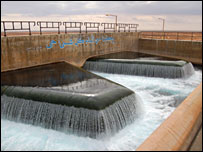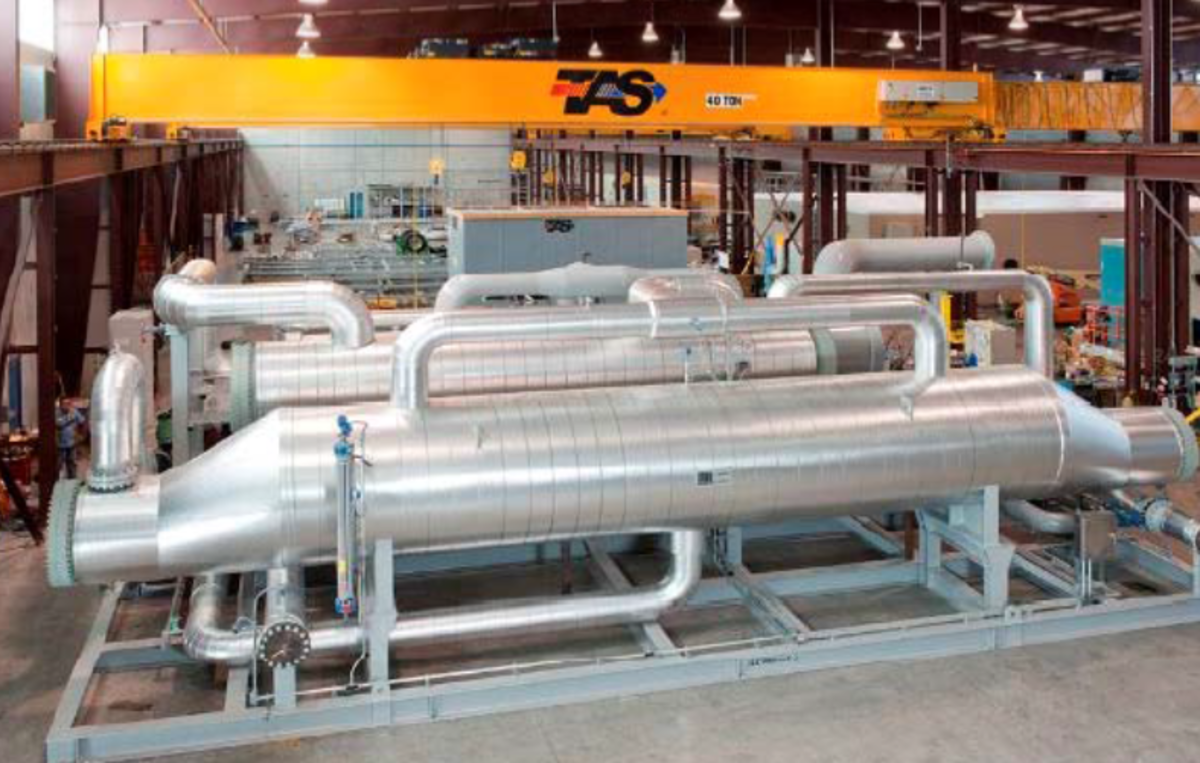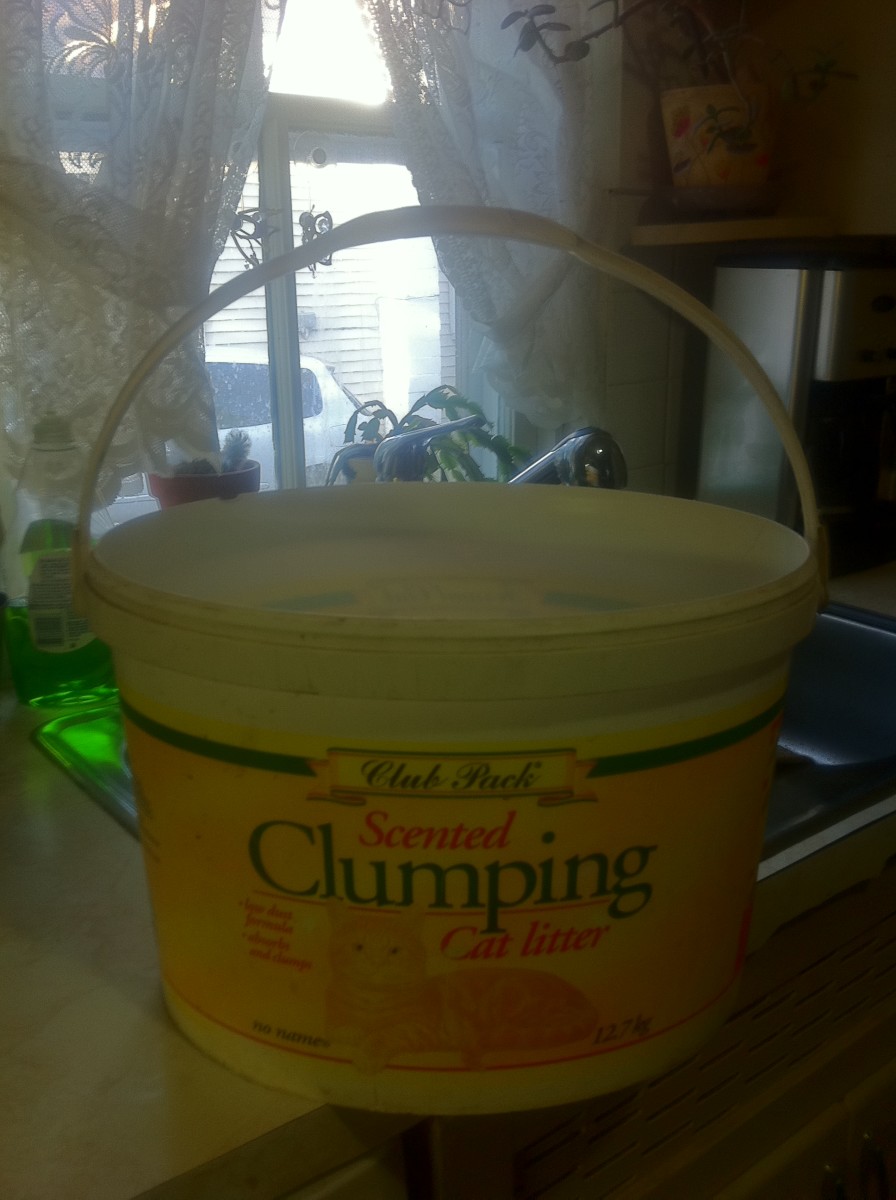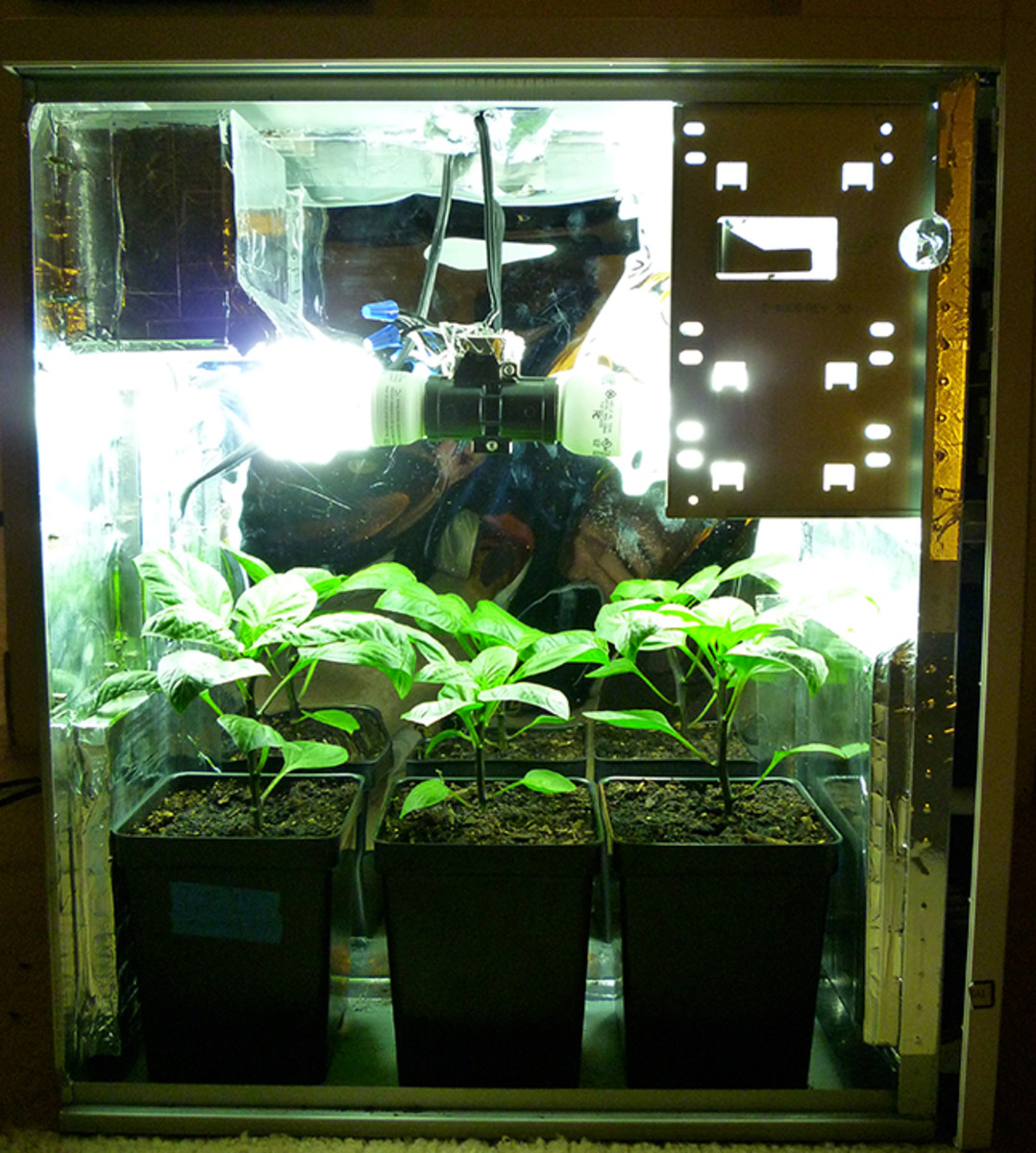Geo-engineering
Scenes like this can be prevented in the future, provided we have the commitment
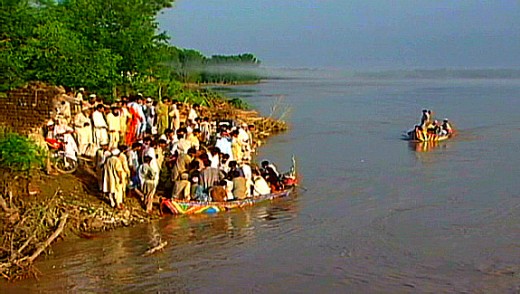
A Proposal for Pakistan
We detail hereinafter a proposal for a solution for flooding disasters. Much of the time, there is political and economic criticism for the way in which things are done and how they should have been handled. Pakistan has gone through its worst flooding in recorded history with nearly 15 million displaced from their homes along with a total write off for crops, stored grains, livestock, homes clothes food and anything else of value. The tragedy is immense and the country is in danger of total collapse. What aid is coming in is too little, too late and there is now a siege of hungry, desperate people fighting over the small amount of aid coming. Disaster capitalism meanwhile is “Johnny on the spot”. Here is a tragedy that need not have even happened if the right projects were in place to handle it. What we are talking here is an international effort in geo-engineering that we can do right now with existing technology. In fact, the Dutch have been doing a small scale of geo-engineering for centuries with nothing more than the wind, windmills and pumps to drain vast stretches of land. Today it is done with electric pumps and pipelines. The vision for the flood plain is to construct collection reservoirs and vast pipelines that divert the flood waters to regions that require water, but don't have much of their own. The dry regions can provide the space for solar power generators to power the pumps. Described hereinafter is the plan of a geo-engineering project that will make disasters like the horrific floods of Pakistan past history and a bad memory. We will look in turn at the advances of;
Hollands water diversion and dyke system
The US-Canadian pipelines for oil and water
Solar electrical generating plants and other sources
The layout of the land for Pakistan and adjoining regions such as Iran and Afghanistan
The water pumping and pipelines of Libya
Windmills have been around for several centuries and have been successfully used to remove flood waters
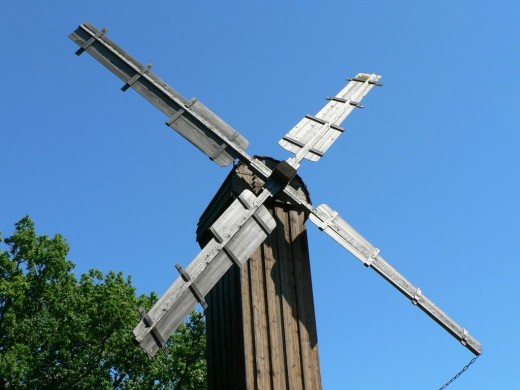
Windmills and water diversion
The wind wheel of the Greek engineer Heron of Alexandria in the 1st century marks one of the first hitorical known instances of wind powering a machine. Form there it went to Tibet and China in the 4th century, used mainly for prayer wheels. The first practical windmills were the vertical axle windmills invented in eastern Persia in the 9th century. Holland, a.k.a., the Netherlands has had some kind of operating system for draining lowlands of water since the 12th century that were first found in France in the region near Belgium, close to Holland, but it didn't really take off until the 13th to 14th century when draining combined with dykes went to truly a geo-engineering scale. To understand how a windmill sail works, let’s look at sailing ships, tall ships and sailing with and against the wind. For much of sailing history, ships have relied on tail winds or at least winds that could drive them forward from a relative rear direction. With the development of the jib, sailing craft could sail somewhat against the wind. Tall ships from form the 17th century and on relied increasingly in jibs as well as square sails. The jib is a triangular sail set between masts or the bowsprit and the foremast. The jib’s orientation was along the line between the bow and stern of the ship as opposed to the square sails that were set on yard-arms attached to the various masts and perpendicular to the mid-line from bow to stern. A jib could catch the winds from the side and also when set properly, catch the wind from either the starboard bow or port bow and act part as sail and part glider. The force of the headwind would allow the jib to transfer the winds energy to the ship which would move it through the water against the wind. However, as the ship could approach the headwind only at an angle, in order to reach a line of sight destination, the ships crew had to “zigzag” or tack one way, then the other way in order to continue sailing to their destination against the wind direction. The advent of the triangular jib sail made sailing more versatile.
Looking back at vertical mounted windmills, we can find various sail configurations including the jib mast combination where the masts are arranged around the central drive shaft. In this case, the sails are oriented into the wind with the aid of a tail and turret like movable mill head. Vertically mounted sails or wings complete with a rudder or tail are typically found in designs that are used to mill grain, extract ground water or to drain water from lowlands. In some regions where wind was constant from a particular direction, the mill head did not have to turn and the jib alone was all that was necessary to keep the mill turning. The jibs alone could be set to best exploit the wind. Other mills were designed for height in order to maximize the sail so that they could work, even in low winds of breezes. Before the advent of electricity, these would be coupled with pumps to move water.
The wind energy captured by the sails that turned the energy of the wind into the rotary motion of a drive shaft attached to the masts, sails, wings or turbine. This rotary motion was then transferred to piston rods attached to an in line crankshaft, or to a differential that directed the energy to a millstone inside the mill housing below. In some cases the wind power was transferred to a mill wheel to move water uphill. Other cases exploited an Archimedes screw for the same ends. In the case of the piston, these were used to draw up water from a low level to a higher level. This relied on atmospheric pressure on the water and the partial vacuum created in the pumps. The Dutch employed the piston design, the water wheel and the Archimedes screw to extract water from the lowlands and to dump it into the seaward side of a dike complex (1). Often several windmills worked in tandem to raise water gradually from a low height to a great enough height to accomplish the task of water removal. Prior to the 19th century almost all windmill working parts were constructed entirely of wood and sail canvas. With the advent of industrialization, the moving parts were converted to metallic form.
Massive pipelines are already proven techonolgy
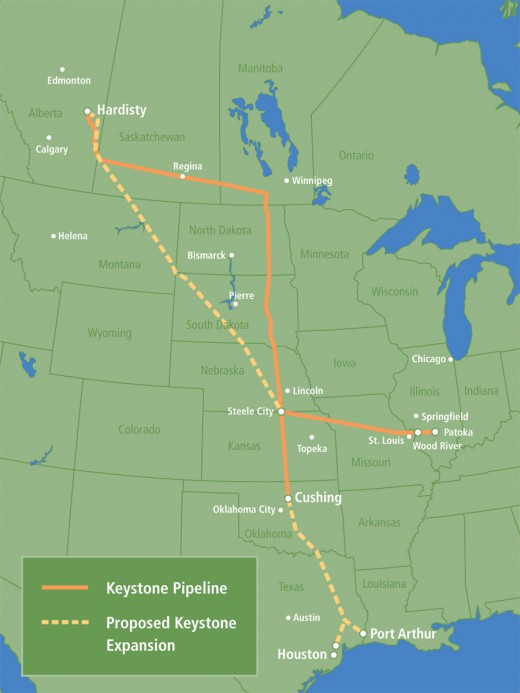
The US-Canadian pipelines for oil and water
Clipper, the Enbridge line that runs 1,609 kilometres (1,000 miles) to Superior, Wisconsin, from Hardisty, Alberta, has a capacity of 800,000 barrels per day. The Calgary-based company is in the process of filling the line to start deliveries by the end of the third quarter.(2)
Latest water pipeline proposal underscores need for national water policy
Bulk water exports was discussed at an October, 2006 conference in Banff where Paul Wihbey, president of a Washington consultancy called GWEST, the Global Water and Energy Strategy Team proposed a freshwater pipeline be built between Manitoba and Texas. Wihbey said “it is nearly inevitable that bulk water exports from Canada” will occur within the next “two to five years.” The pipeline under question has since been constructed and is one of the largest geo-engineering projects to date. “This is the latest in a series of calls for Canada to relax its regulations and allow bulk water exports to the United States,” says Maude Barlow, chairperson of the Council of Canadians. “Canadians are becoming increasingly impatient with the federal government’s refusal to deal with the problem.”“Prime Minister Stephen Harper has failed to clarify his government's position on bulk water exports, and the Conservative government has done nothing to address growing concerns about the stability and quality of Canada's water supply,” says Susan Howatt, national water campaigner for the Council of Canadians. With polls showing that Canadians feel strongly about the issue, a failure to address bulk water exports will severely harm the Conservative Party in the next election according to the citizens’ advocacy group. A poll released last week by the Canada Institute of the Washington-based Woodrow Wilson International Centre for Scholars and the Toronto-based Canada Institute on North American Issues found that while 72% of Americans favoured exporting more water from Canada to the United States, 76% of Canadians opposed bulk water exports. The Council of Canadians demands that a new national water policy for Canada ban the export of water, implement strict restrictions on diversions, and affirm the role of the federal government in international water issues. (3)
This situation exists because of sovereignty issues between national regions. Under capitalist direction, the main concern is for profit without concern for any other issue. But in an international world, a region that is rich in a resource can be directly connected to a region that is poor in the same resource. If one region is subject to flooding due to an overabundance, then that excess can be diverted to a region that is short of water and can absorb the excess. To do this is effectively, we are going to have to deal with such questions in an international manner. If anything has been learned from the above, it is that it can be done with current technology over vast regions, making such a project for Pakistan to prevent flooding disasters in future, a desirable goal.
A few types of solar power generation are available which can be built in desert regions.
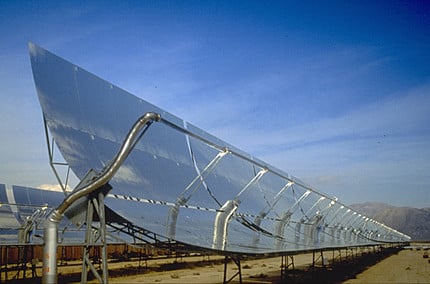
Solar electrical generating plants and other sources
Solar farms come in a few basic configurations. They sometimes use conventional photo-voltaic cells, mirrors and conventional heat exchangers or parabolic concentrators focused on pipes containing fluid that is heated and recycled. There is also a design that captures solar energy using a tower containing a horizontally mounted wind driven turbine. A couple of promising energy sources are detailed further.
Infra red sources for energy
Solar energy has seen a recent development with paint on solar cells that create electrical energy. It is now possible to derive power from infra red energy sources. These devices can work at night, on cloudy days and even from waste heat from buildings, cars and our own bodies. The basic principle of these infra-red solar cells is the same as that for visible light solar cells. The use of certain chemicals in combination captures photons that cause the release of electrons via the photo-electric effect and these can be directed to run circuits or collected in batteries or capacitors. Infra-red energy exists in abundance all around us and should be tapped for energy needs. As it stands now, almost all of the infra-red energy just vents into the environment and eventually into space.
Geothermal energy
Geothermic or geothermal energy is that which is sourced from the internal heat of the Earth and is put into use in heating homes or driving steam powered turbines. Geothermic energy has been proven effective and efficient, with one of the highest efficiency ratings that can be given to any energy conversion system. Many areas of the world are suitable for obtaining and using this energy, but most of them remain unused in favor of other sources such as fossil fuels, nuclear, hydro or wind energy. Geothermic energy where extracted has proven to be reliable over extended periods of time. Currently, this is the form of energy that is used in places like Iceland, the Philippines, California, Italy, Africa, New Zealand and many other places. Iceland boasts the highest percentile of its power production based on geothermic sources.
Some sources of this energy are natural, occurring around hit springs, like the ones found Near Harrison British Columbia, or in Yellowstone National Park in the US. Others can be created where there are known hot places near the surface of the earth, but are dry. Within the earth, near the source of heat, is a reservoir of water which gets super heated by the magma that is close by and supplying the heat, and the water then works its way to the surface in the form of hot water springs or geysers. Dry hot spots can be developed by injecting water into the hot zone and then tapping the heated water or steam to do what we want to generate power of to heat homes.
The best places for constructing geothermal plants are near the plate boundaries of the planet where large tectonic plates jostle and rub against one another on the lithosphere of the dynamic Earth. This natural tendency creates plenty of natural hot spots. This is one reason why Iceland is ideal, but the western coast of the Americas and eastern coasts of Asian are also ideal for similar reasons. The ideal spot is where super heated water or steam erupts from a hot spot below the surface. A power plant can be placed nearby to capture the steam and use it to power turbines for the generating of electricity. The steam can also be used to heat buildings directly without turning it into something else. The size of the power plant is limited only by the amount of the natural resource available. As it stands now, most natural sources of geothermal energy just vent into the air without being used.
Pakistan is a diverse and complex geological region
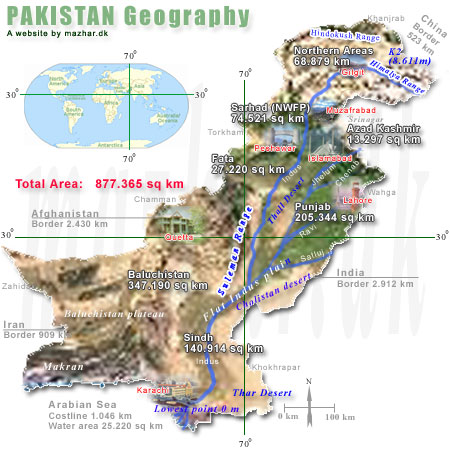
The layout of the land for Pakistan and adjoining regions such as Iran and Afghanistan
The geography of Pakistan is a profound blend of landscapes varying from plains to southern deserts, forests, hills, and plateaus ranging from the coastal areas of the Arabian Sea in the south to the mountains of the Karakoram range in the north. Regions that are subject to flooding such as near rivers and the lowlands, especially during the monsoons, such as the terrible record monsoon disaster of 2010, should provide the source for the pipeline to deliver water to the southern desert of the Indus Plain regions that need it most. Water can be stored in vast reservoirs to be used later. With adequate control, no one in Pakistan need ever suffer the ravages they experienced in one of the worst disasters in history.
The water pumping and pipelines of Libya
“In August 1984, Muammar Al Qadhafi laid the foundation stone for the pipe production plant at Brega. The Great Man-Made River Project had begun. Libya had oil money to pay for the project, but it did not have the technical or engineering expertise for such a massive undertaking. Foreign companies from South Korea, Turkey, Germany, Japan, the Philippines and the UK were invited to help. In September 1993, Phase I water from eastern well-fields at Sarir and Tazerbo reached Benghazi. Three years later, Phase II, bringing water to Tripoli from western well-fields at Jebel Hassouna, was completed. Phase III which links the first two Phases is still under construction. Adam Kuwairi, a senior figure in the Great Man-Made River Authority (GMRA), vividly remembers the impact the fresh water had on him and his family. "The water changed lives. For the first time in our history, there was water in the tap for washing, shaving and showering," he told the BBC World Service's Discovery programme. "The quality of life is better now, and it's impacting on the whole country."(4)
The scale of the project would rate this one as geo-engineering and it is one that exists. However, since it is tapping into “fossil water” reserves, it has a limited and indeterminate future. Sustainable geo-engineering has to take into account factors such as described in the case of Pakistan and to a lesser extent, Canada and the US. In this description, we have not discussed China, which suffered a worse flooding disaster than Pakistan. But China has already proven itself in its own brand of geo-engineering, such as the Three Gorges Dam, which is not without controversy. But the Three Gorges Dam was not about averting floods ans the proposal above addresses. China continues to have floods from monsoon rains, just as Pakistan and is a study in itself. It is hoped that the government of China and Pakistan recognizes the importance of such a project to ensure the safety and benefit of the people in both regions. Above all, the geo-engineering projects considered need to be done internationally. The Canadian-US exercise in geo-engineering has been designed for maximizing profit and the concerns of the people hardly exist outside of consumerism. A humanitarian geo-engineering project, which we advocate and support, would be designed to maximize on sudden influxes, to distribute this to regions suffering a lack thereof and to prevent the kind of disasters we have seen and continue to see unfold.
Libya's mammoth water delivery network is a geo-engineering project in its own right
